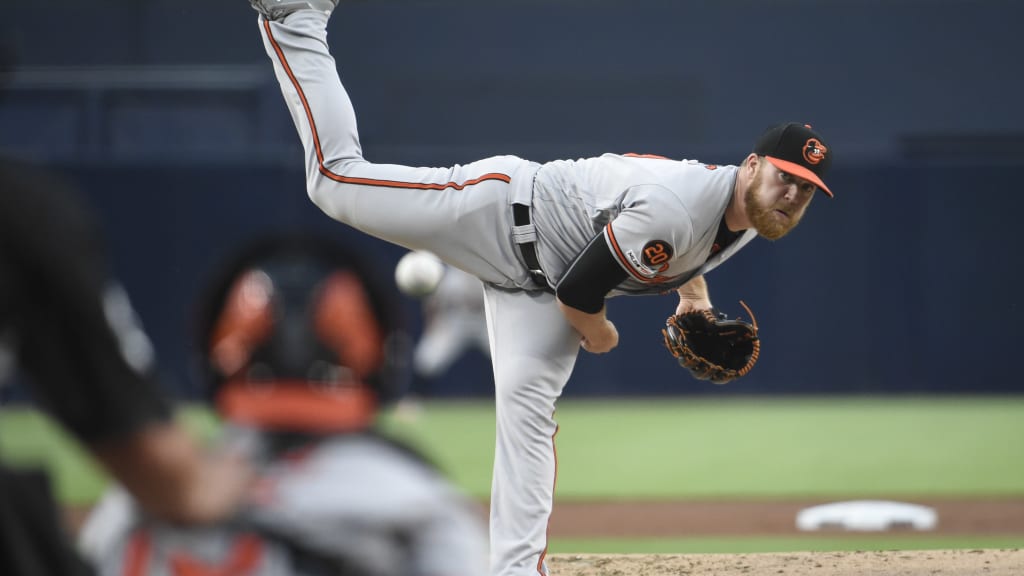
SARASOTA, Fla. -- Anyone who knows David Hess, the Orioles righty says, knows that he “has decently thick legs.”
You read that right.
Hess calls them “tree trunks,” and jokes “finding jeans is tough sometimes.” His fiancée chides him for them regularly. When teammates introduce him to friends both inside baseball and out, they reference his legs. They can even be the first thing some notice when meeting Hess for the first time.
“His legs are just ginormous,” O's new bullpen coach Darren Holmes said. “I lift and I want to get big legs, but I don’t think I want them legs. They’re so big!”
They’re also distinctive enough to stand out in a crowd. Hess learned that in January, shortly after deplaning a flight to Orioles minicamp**.** At the other end of the Sarasota airport terminal was Holmes, who was hired this winter and had never met Hess in person. But he’d dissected video of Hess from afar, and consulted him remotely via phone and text. Holmes recognized his new 6-foot-2, 180-pound pupil instantly.
“It looked like he jumped off the top bunk and into his jeans -- just skin-tight, monster legs,” Holmes remembers. “I said, ‘I wonder if that is David Hess …’"
Wanting to introduce himself but not wanting to be wrong, Holmes texted O’s pitching coach Doug Brocail for assurance: “I think David Hess is on my flight.”
“How do you know?” Brocail replied.
“Because,” Holmes wrote back. “He has ginormous legs!”
Holmes was right, and the two look back laughingly now on their first meeting. But it also speaks to the focus with which Hess tackled his work this winter, which he spent studying the mechanisms of his delivery and the intricacies of the way his body moves.
With the help of St. Louis-based P3 Premier Pitching and Performance, Hess’ lower half became the foundation of his training coming off a season where he pitched to a 7.09 ERA, plummeting down the Orioles’ depth chart as a result. He now sees it as the nexus of a kinetic chain that dictates not only his delivery, but also a series of tech-based adjustments Hess hopes have him approaching the corner he needs to turn.
"It was about understanding the movement patterns that we wanted to achieve,” Hess said. “The efficiency of how I was transferring energy through my delivery. That’s a fancy way to say it.”
The non-fancy way?
“I was cutting myself off [in my delivery] a little bit [last year]. It was more about maximization to see the pitch efficiency. Instead of only having 75 percent threshold, now I can open that door a little more. And maybe my 93-mph fastball plays a little better than 93, because it’s easier to achieve and there is less toll on your body.”
For that insight, Hess credits the staff at P3, the facility that helped John Means transform from non-prospect into the O's ace last winter. Though he and Means had different focuses at P3 (“He’s 6-foot-4, a donkey of a man … ,” Hess says. “ … and I’m not.”), Hess was drawn to the facility for the same reason. It was there that Means underwent similarly high-tech mechanical evaluation and learned elements of pitch design prior to last season.
The result was 3-4 added mph of fastball velocity and the initial development of his now-signature changeup, which helped the rookie left-hander blossom into an All-Star. At this point last year, few saw that in Means’ future.
“He was trying to figure out what the best method was for him to try to improve his stuff,” said Means. “He saw the jump I made and we exchanged the contact info.”
Soon, Hess was in suburban St. Louis, consulting with P3’s Josh Keesell and Austin Meine on an offseason strategy. He spent several days at the facility for high-speed camera and Rapsodo screening before taking an individualized plan to complete back home in Greenville, S.C., which was heavy on plyo-ball and band work. Hess then recorded and sent slow-motion video of himself throwing to the P3 staff, Brocail and Holmes throughout the winter, requesting as much feedback as possible. He eventually met up with Holmes in Johnson City, Tenn., for additional individual sessions.
The Orioles were drawn to Holmes, who had been on the Rockies' staff since 2015, in large part due to his extensive background in biomechanics and experience at high-tech training facilities like Driveline. For Hess, this fell right in line with what he was trying to accomplish with P3.
“He went there and looks really, really good,” Means said. “The ball is exploding out of his hand.”
Whether that’s enough to head north with Baltimore on Opening Day, only time will tell. Given his place near the periphery of an ultra-crowded mix currently running about 10 deep, Hess’ clearest path to the roster may be as a reliever, particularly if his improved stuff plays up in shorter stints. It’s a possibility the O's are likely to explore while stretching Hess out this spring, after he was relegated to the ‘pen last season.
“I’m prepared to come into camp and get guys out. I’m here, so use me however is best suited to help the team win,” Hess said. “Regardless of whether I’m starting or relieving, every pitch matters. Every pitch has to have 100 percent intent behind it.”
